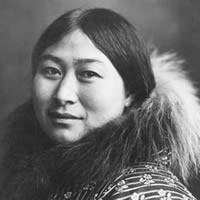The Creole Eskimo are a distinct people group in Alaska, descending from intermarriages between Russian settlers or fur-company employees and Indigenous Alaskan populations (such as Yupik, Aleut, or Inuit groups) during the Russian colonial era in Alaska. Their mixed heritage is reflected in the term "Creole" (in the Alaskan context meaning people of mixed Native and Russian ancestry). Historically, these mixed communities emerged under the governance of the Russian American Company and the Russian colonial administration in Alaska prior to the sale of Alaska in 1867.
In terms of language, although many Creole Eskimo speak English today, there remain traces of a dialect often termed "Alaskan Russian" (or Old Russian) in some communities—particularly on Kodiak Island or the Kenai Peninsula—where Russian influence persisted for over a century. Over the generations, however, the predominant everyday language has shifted to English, with Indigenous languages and Russian heritage languages being much less widely used. According to mission-oriented sources, English is listed as the "main language" for this people group.
The life of Creole Eskimo people today is shaped by their heritage, the rugged geography of Alaska's coastal and island regions, and the interplay of tradition and modern life. Many live in small, often remote communities along the south-coast, southwestern and southcentral coastal regions of Alaska. Their daily lives can include subsistence activities—such as fishing, gathering shellfish, hunting marine mammals or sea-birds, and harvesting berries—as well as participation in the cash economy through jobs in local government, tourism, small businesses, or service industries.
Because of their mixed Russian and Indigenous heritage, Creole Eskimo people often sustain cultural practices that reflect both Indigenous Alaskan traditions and influences from Russian-Orthodox or Russian-influenced culture (for example in cuisine, place names, family networks, and heritage identity). The geographic isolation of many communities means that infrastructure, access to healthcare and education, transport, and economic opportunities may be more limited than in urban areas. Younger generations are increasingly mobile, moving to regional hubs or outside Alaska for education, work, or access to services, which in turn impacts community cohesion, traditional lifestyle, and language transmission.
Social dynamics in these communities may include grappling with the legacy of colonialism, economic pressures, substance abuse, and cultural dislocation. At the same time, many Creole Eskimo people are intensely proud of their mixed heritage and actively seek to preserve community identity, cultural memory, and family ties.
The Creole Eskimo people inhabit a spiritual landscape shaped by multiple influences. Historically, Indigenous spiritual traditions among Alaska Native peoples emphasized animism, respect for the land and sea, ancestors, spirits of animals and environment, and strong traditions of community ritual. With the arrival of Russian Orthodoxy during Russia's colonial period in Alaska, many of the mixed-heritage Creole communities adopted the Russian Orthodox Christian faith or blended it with Indigenous beliefs.
In contemporary times, many Creole Eskimo people identify with Christianity (often Orthodox or Protestant), though the degree of adherence and the blend of cultural-spiritual practices varies widely. Mission-oriented data suggests that a minority are evangelical Christians, while a large proportion remain aligned with ethnic religions or traditional spiritual worldviews.
Therefore, religious belief among Creole Eskimo people can be described as pluralistic: some are committed Christian believers, some practice a mixture of Indigenous and Christian traditions, and others maintain traditional spiritual values without formal affiliation. This syncretistic environment offers both opportunity and challenge for spiritual engagement.
The Creole Eskimo people have a number of tangible and spiritual needs that are vital for respectful engagement, community support, and lasting transformation. They require access to culturally appropriate economic opportunities and infrastructure, as their remote geography and limited services often hinder employment, education, healthcare, and sustainable livelihoods.
The Creole Eskimos also need spiritual engagement. Messages of hope in Christ should be shared in ways that the Creole Eskimos will understand and embrace. Finally, there is a great need for vibrant local leadership among their own people—credible believers, capable church planters, and community workers who understand their cultural context and can model the integration of faith and heritage.
Pray that the Creole Eskimo believers would have hearts of compassion for the lost around them and preach the gospel with love and grace.
Pray for the great work of the Holy Spirit to touch the lives of the Creole Eskimo people.
Pray that God would raise up indigenous Christians to lead and shepherd their communities for the saving of souls and for God's glory.
Pray that hearts would be stirred in missions' organizations to reach these dear people with the gospel of Christ.
Pray for believers working among Native people to be sensitive, patient, and guided by the Holy Spirit.
Scripture Prayers for the Eskimo, Creole in United States.
Wood, M. M. "The Russian Creoles of Alaska as a Marginal Group." Alaska History, vol. 8, no. 3, 1943. JSTOR
AlaskaWeb.org. "Alaska Native Groups & Cultures."
Wikipedia entry "Alaskan Russian" and "Alaskan Creole people."
| Profile Source: Joshua Project |










